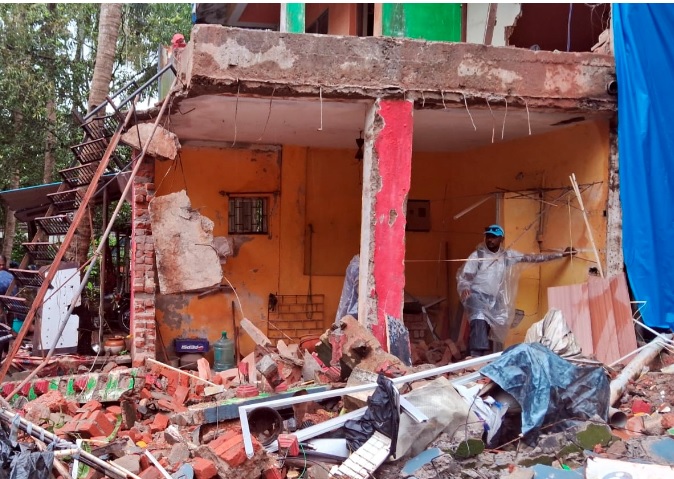
MAPUSA
North Goa, with its pristine beaches, bustling nightlife and vibrant tourism scene, has long been a magnet for both domestic and international tourists.
The area is renowned for its sun-soaked shores, party hotspots and a thriving hospitality industry that fuels Goa's economy.
However, beneath the glossy surface of paradise, recent developments have exposed an undercurrent of unrest that threatens to tarnish the allure of the region.
Once employed to maintain order, hired security personnel or bouncers are now increasingly becoming the perpetrators of violence, further complicating the already delicate balance in North Goa's tourism-dependent economy.
Outsiders fuelling chaos?
In a surprising twist, many of the clubs, hotels and restaurants in the area, owned and managed by non-Goans, have been accused of exacerbating the problem.
These businesses, including high-profile beach clubs and nightclubs, employ bouncers for personal protection and crowd control, but the role of these individuals has morphed into something more sinister.
These bouncers, many of whom are not Goan natives, have begun to act as enforcers for their employers, embroiling themselves in activities that range from violent assaults to illegal property evictions.
One of the most alarming incidents in recent times occurred in the famous Tito’s Lane in Baga, an area synonymous with Goa’s thriving party scene.
Two brothers were brutally attacked by a group of 10 to 15 bouncers armed with wooden clubs, resulting in severe head injuries.
The attack was caught on CCTV, which revealed that even the owner of the club, Maninder Singh, alias Pagi, was allegedly involved.
Despite clear evidence, the police response was sluggish, with arrests delayed and the main perpetrator managing to escape custody, further fuelling public outrage.
The club was eventually sealed, but the incident left a bitter taste in the mouths of locals and tourists alike.
This violent episode, like others, has highlighted the complicity of some club owners in orchestrating or allowing such attacks, as well as raising serious questions about the role of law enforcement.
Police under fire
The role of the Goa Police has come under intense scrutiny, as residents and stakeholders in the tourism industry question the force's ability – or willingness – to control the growing lawlessness.
Despite having the authority to take swift action, there are allegations that the police are deliberately dragging their feet when it comes to lodging FIRs or making arrests, seemingly waiting for instructions from higher authorities.
This was evident in another high-profile case in Assagao village, where a group of bouncers, including female enforcers, were hired to illegally demolish part of a house in a dispute over its ownership.
The demolition was carried out with heavy-handed tactics, allegedly under the watchful eye of local police, who claimed they were under pressure from higher-ups to look the other way.
The lack of immediate legal action following such blatant law-breaking has only further undermined public confidence in the police.
In Siolim, another popular area in North Goa, bouncers from the well-known nightclub Thalassa were arrested after assaulting tourists and attempting to extort money from them.
The incident, which occurred nearly a year ago, was one of several that demonstrate a disturbing pattern: bouncers taking on the roles traditionally associated with criminal gangs, using violence to settle disputes or intimidate others on behalf of their employers.
Emerging patterns of violence
These are not isolated incidents. In fact, a clear pattern is emerging, in which bouncers are being employed as muscle for nefarious purposes.
They have become an unsettling presence along the coastal belt, contributing to an atmosphere of fear and intimidation that threatens to destabilise the tourism industry.
Beyond bouncer-related violence, other criminal activities continue to plague North Goa's coastal belt, particularly in Calangute.
The area has seen an increase in illegal dance bars, massage parlours and touts preying on unsuspecting tourists.
These touts, many of whom are non-Goans, lure tourists with false promises of services, including massages and illegal activities, only to rob or extort them.
Instances of tourists being beaten when they demand refunds have been reported, further tarnishing the region’s reputation.
Local residents have staged multiple protests, demanding the closure of illegal establishments and the removal of touts who exploit visitors.
Despite these efforts, the problem persists, with many accusing authorities of turning a blind eye.
Tourism industry at risk
North Goa’s tourism season is now in full swing, but these troubling developments threaten to dampen the influx of visitors.
The rising frequency of violent encounters involving bouncers, combined with the unchecked operations of touts and illegal establishments, is painting a bleak picture of the region.
While some may argue these are merely stray incidents, there is growing concern that they reflect a deeper malaise within Goa’s tourism infrastructure.
With the constant dissemination of such incidents through social media, the damage to the State’s reputation is amplified.
Once synonymous with carefree beach holidays and lively parties, North Goa is now gaining notoriety for violence and corruption.
This negative publicity could deter potential visitors, affecting not just businesses directly involved in these incidents but also the wider hospitality sector.
Threat to tourism industry
Goa’s tourism industry is at a crossroads. As the state prepares for a new season, it must grapple with the twin challenges of curbing violence and restoring law and order.
The involvement of bouncers in violent crimes, combined with the police's apparent reluctance to act decisively, has created a volatile situation that could jeopardise the entire industry.
If left unchecked, these disturbances could leave lasting scars on North Goa’s coastal belt, damaging its appeal as a premier tourist destination.
As the authorities continue to face pressure from local residents, business owners and tourists alike, decisive action is needed to restore the State’s reputation as a safe, welcoming, and vibrant destination.
The question remains: Will the authorities step up to the challenge, or will North Goa’s coastal paradise be further marred by unrest?